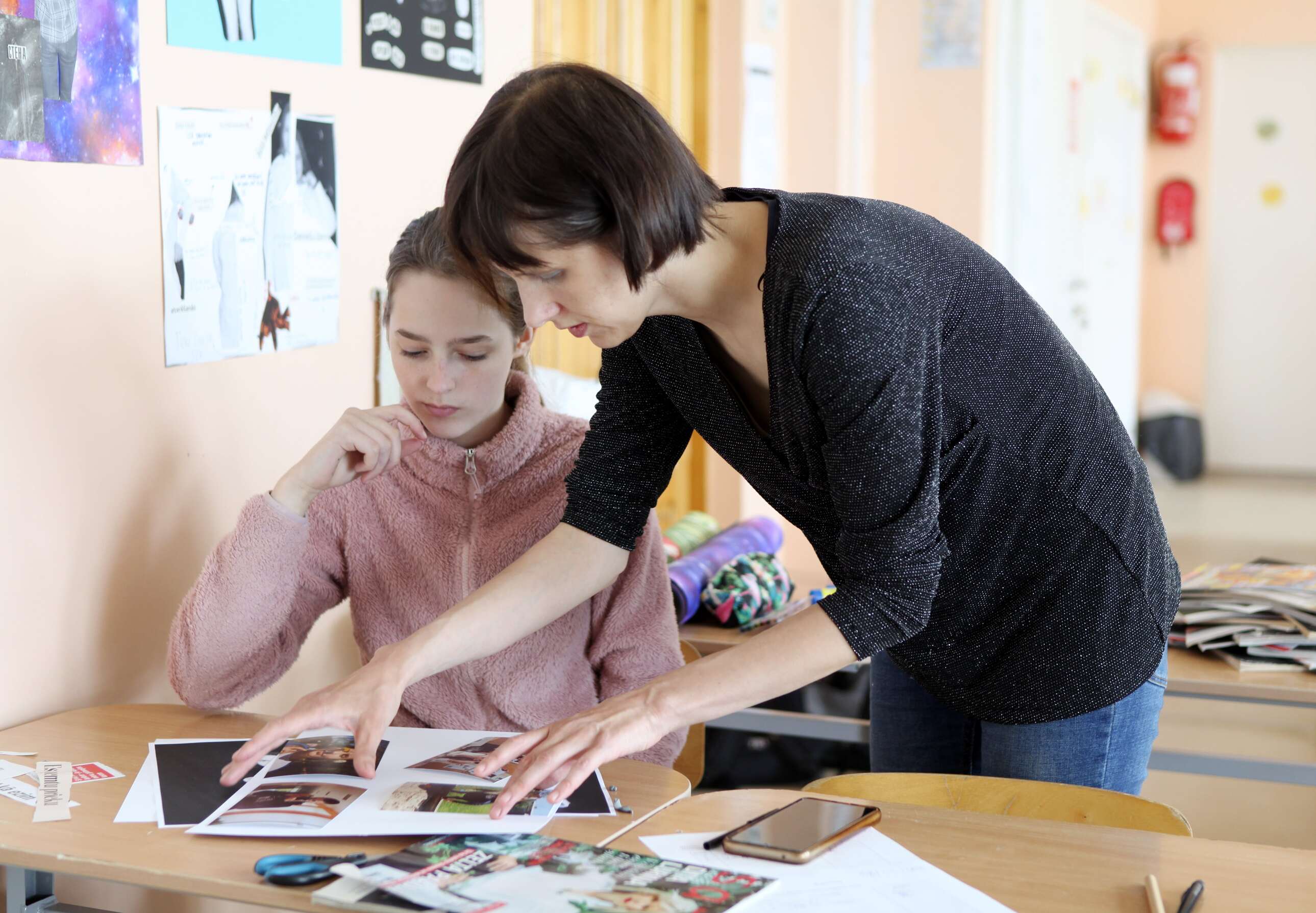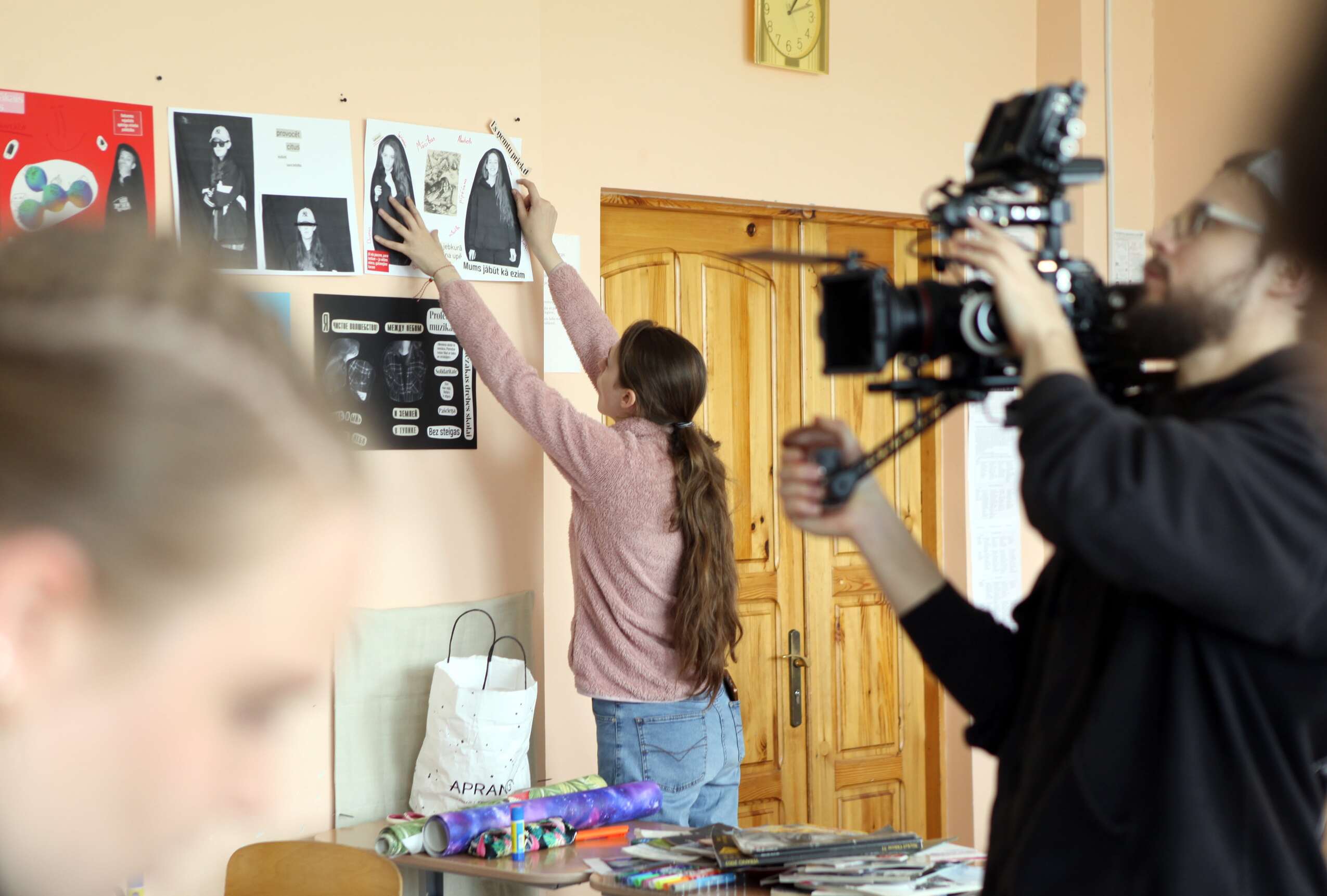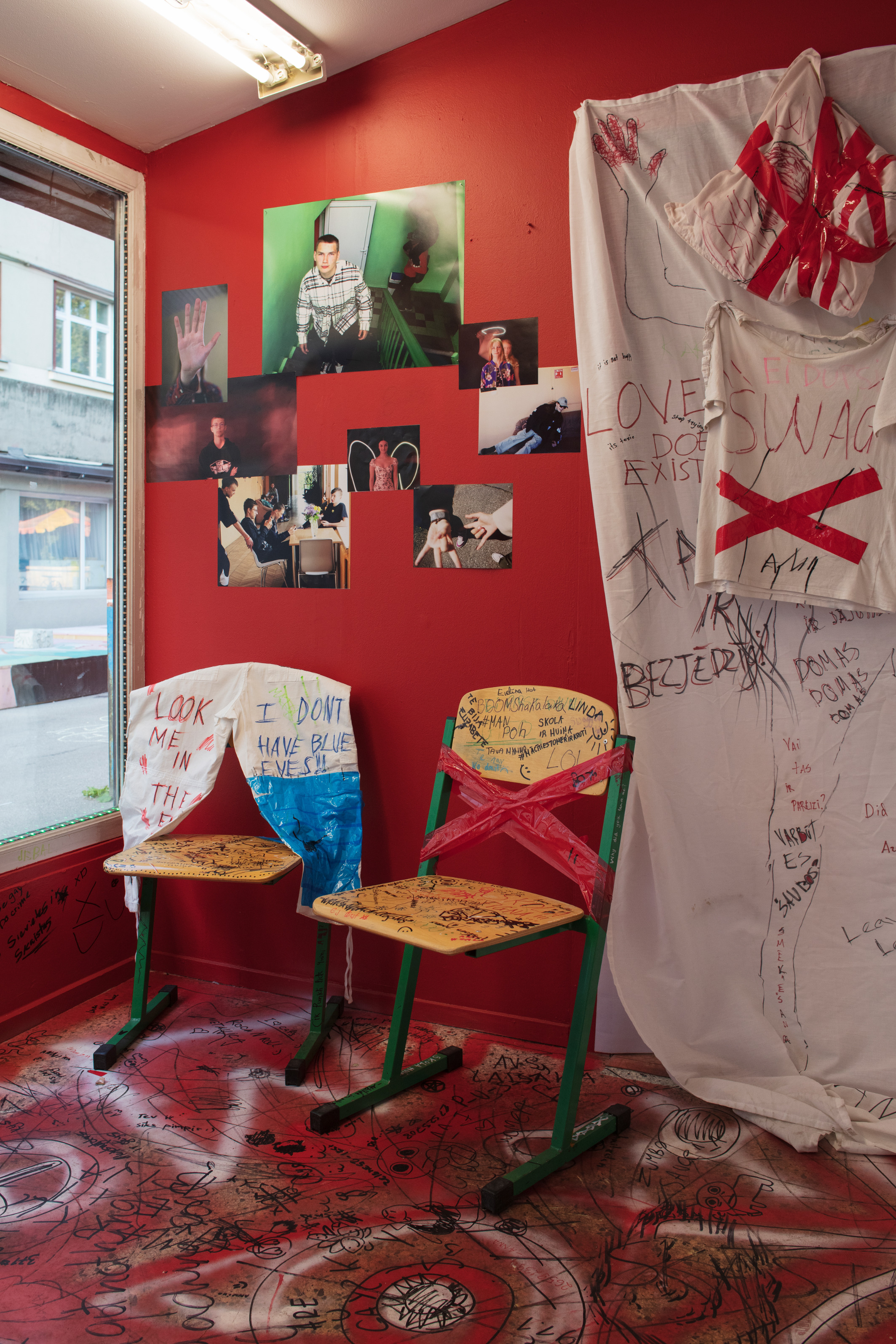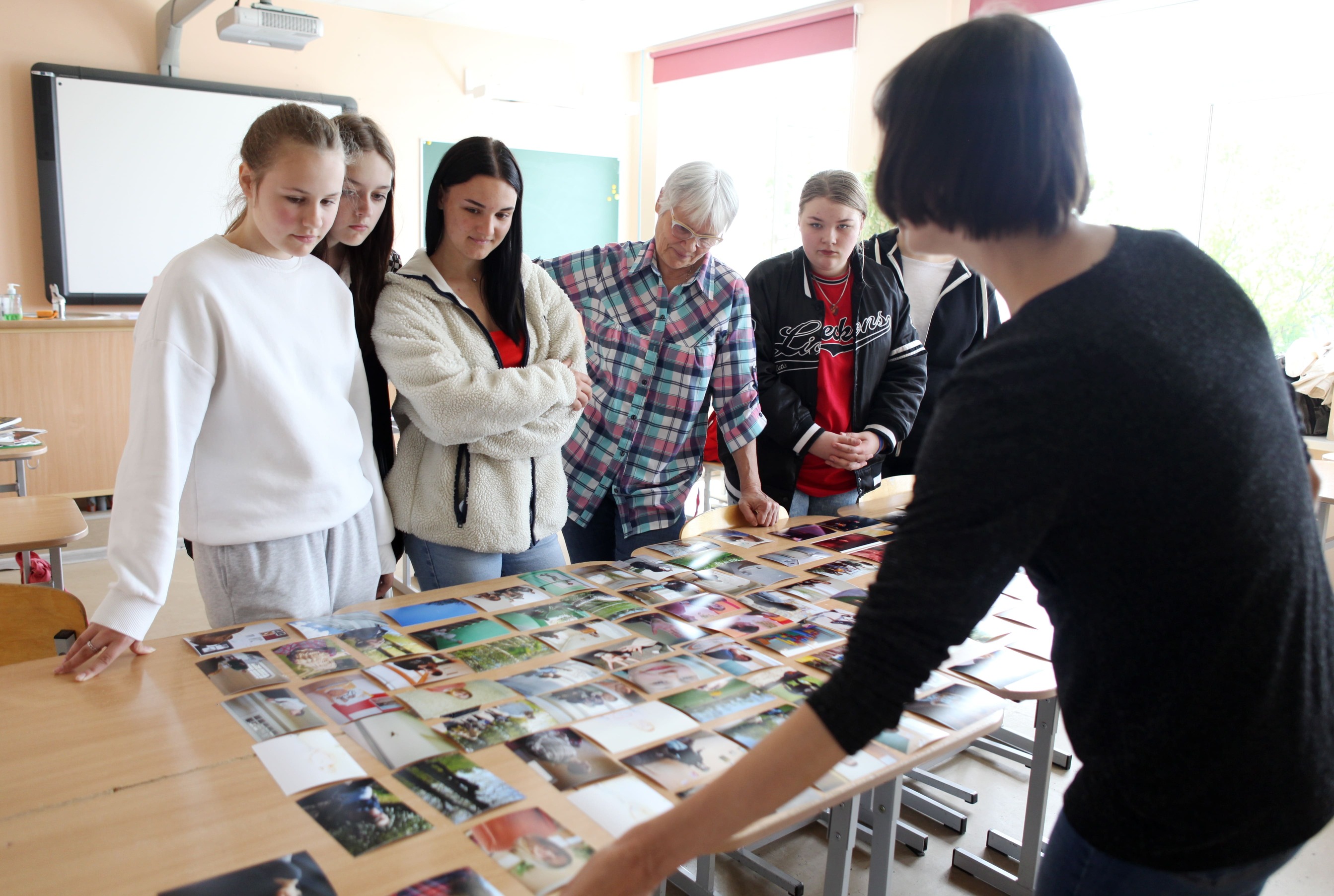May 31, 2024
“Manifesto to youth” – Vika Eksta at Aglona Secondary School

As part of the project, seven Latvian artists visited six schools throughout Latvia where they took part in art residencies with students.
Read and get to know what Vita Eksta did in Aglona!
Who? The artist Vika Eksta and students from Grade 7, 8, 10 and 11
When? In May 2023, over the course of an intensive 2-week residency
Where? At Aglona Secondary School
Other people involved? Velga Puzo, teacher of the Theatre extracurricular, and the art mediators Aija Putniņa, Kristīne Ercika and Mariona Baltkalne
Watch here: Vika Eksta’s residency at the Aglona Secondary School
Although we always seem as stable and self-sufficient entities to ourselves, in a paradoxical way we tend to completely change across our lives and to become entirely different during our lives. In the present, we seem ready, complete, and we seem to know everything about ourselves, but when we look back at the past, we see a completely different personality, which, observing from the point of view of this moment, is trying to find a place in the changing conditions of reality. One of the most drastic changes in form and content occurs in youth, when for the first time we become aware of our abilities, power and also how small we are when set against the vast world full of opportunities and risks. At this point we have to prove ourselves and prove to ourselves. It’s an tumultuous moment. However, no matter how it goes in that moment, after multiple years and several changes of our shell and in our body, it will be very interesting for us adults to reacquaint ourselves with our teenage selves and to admire the courage and daring that we once possessed.

The artist Vika Eksta decides to do her “The Artist Is Present” residency at Aglona Secondary School. This is due to two circumstances: first, this side of Latgale is the place where Vika’s parents reside – she has the opportunity to settle near this school which is far away from Riga. Secondly, the aim of “The Artist Is Present” is to introduce young people to contemporary art practices throughout Latvia – not only in easily accessible schools in big cities, but also in more remote regions where access to cultural activities is limited due to various logistical difficulties. Small rural schools are in a fragile and anxious state due to current education policies. The number of students is rapidly shrinking, and the priorities of the local communities tend to shift in favor of addressing economic rather than cultural issues. Additionally, the life of a small provincial school is significantly different from the large institutions of state cities with hundreds or even over a thousand students. Here, the student is part of a small community, which is bound by much closer social and relational ties.
Aglona Secondary School is no exception to this, and such an attitude, marked by strong interest at all levels, is beneficial to the collaborative creative process of the artist Vika Eksta and the students. Vika Eksta is a recognized Latvian artist who works with photography, video and studies of visual archives, and she has also found her calling in performance. In her works, she assesses various layers of human behaviour, as well as empathises with the environments that created them, combining the rigour of attention in anthropological research with a warm-hearted attitude. She has studied photography with Andrejs Grants and at the EFTI photography school in Madrid, and has received a master’s degree in Visual Communication from the Art Academy of Latvia. Vika is the recipient of the ADC Young Guns, FK “Portfolio” and the Riga Photography Biennial Award for Young Baltic Photographers, and has been nominated for the Purvītis Prize. In parallel with this, Vika Eksta has been leading photography master classes for a wide variety of interested groups for more than ten years, and has accumulated extensive and versatile experience in the field of pedagogy.
Vika decided to work with students from Grade 7, 8, 10 and 11, because youths of this age are already able to work independently and can be entrusted to work with more complex techniques. Unfortunately, the Grade 9 and 12 students could not participate, even if they wanted to – preparing for the upcoming exams takes all their free time. After the introductory class, about half of the thirty people present decided to continue their journey with Vika. The students are very interested and everyone tries to attend the classes. Sometimes it is not easy – the master classes take place during the regular school hours, so you have to miss other classes if you wish to attend.
Initially, the most active students take the initiative, but as they gradually gain encouragement, the more quiet ones also open up, asking a lot of questions about technique and process. Vika’s master class plan is the most intensive one out of all “The Artist Is Present” residencies. If the other artists visit their schools 2-3 times a month, then all of Vika Eksta’s classes are scheduled to take place within about two weeks. This is because it is a long road to Aglona – it is about 230 kilometers away. Therefore, the art mediator Aija Putniņa can only participate in some of the classes led by Vika. Occasionally, she is substituted by Kristine Ericka and Mariona Baltkalne.

Vika carefully plans the lesson times – initially they take place every other day, to allow the students to reflect on what they have seen and done, but in the second half of the residency, when everyone has warmed up, the creative process picks up speed. In this way, students can quickly and purposefully implement their ideas while they are still fresh. Velga Puzo, the teacher of the Theatre extracurricular, is great support for Vika – she helps organize work so that it would be in line with the school system, and is also actively involved in the master classes. In this case, the teacher is not just a passive observer from the sidelines, a supervisor of classroom discipline, but a participant in the creative process who, together with her students, is learning new methods and techniques, later shares their thoughts, and is able to pass this experience on to future students, later on already by herself, without the artist-in-residence of “The Artist Is Present” being there.
Velga Puzo says the following about the importance of “The Artist Is Present”: “By working like this, children learn what contemporary art is. They feel themselves as a part of this art, and they can also become those who express it. They look at a piece of art and think. It’s a thought process.”
The theme of this series of master classes is “The Youths’ World”. Vika is interested in how the youths who are still in a process of change see each other and the environment around them, and therefore she hands the camera over to the youths themselves. In the chemistry class, the group sets up an improvised photo studio with the necessary starting equipment for learning photography. At the same time, it is a safe space for free, uncensored expression, which the youths strongly appreciate. By staging compositions or simply capturing the important moments of their lives, they are given an opportunity to express their values and outlook. What is captured in the image is then discussed together afterwards.
The student Gabriela says the following about her experience in the residency: “They understood us and accepted what we said. In class, we cannot express our thoughts and emotions, but here we express them. Vika adds and tells you about things, and you understand – yes, it really is like that. It’s like psychology of its own kind.”

To learn the basics of photography, the youths try out different tasks. When creating self-portraits and documentary coverage, they get to know professional nuances – how to set up lighting correctly, the use of shutter speed and aperture, and others. There is also homework and, by signing a special document, cameras are taken outside the school to capture glimpses of the “real” life that begins outside the educational institution. Cameras were kindly provided by the company Sony Latvia. Besides working with cameras, Vika introduces the students to the making of collages. She believes that collage is the most powerful way to prompt people to express their thoughts about the world. Once something has already been printed and is then selected for use again, an image creates a fresh and original meaning together with a title that is aptly found, cut and pasted into the overall composition. These are loud messages that are attached to the walls of the classroom and later also make their way to “The Artist Is Present” exhibition at the Vidzeme Market in Riga.
At the contemporary art camp in Valmiera, organized by the Latvian Centre for Contemporary Art, Vika continues the work started together with the group of students from Aglona Secondary School. Their main task is to agree on the concept of the exhibition, select what is most appropriate and best from the already rich photo material accumulated, and to extend it further. Here too, behind the stage of the concert hall “Valmiera”, they create a photo studio, where the youths from Aglona are working, and a master class takes place for the children of Valmiera. Belén Santillán, a representative of the Norwegian artist group Tenthaus, is actively involved in everything that is happening. The youths decide to supplement the installation with clothes covered in texts and drawings.
At the Survival Kit 14 exhibition, the work made together by Vika Eksta and the Aglona Secondary School students Linda Demjanova, Emīlija Gražule, Sintija Indrikova, Kitija Kalinkeviča, Inta Kraupša, Megija Lukjanoviča, Laura Matisāne, Armands Matisāns, Elīna Nastiša, Evina Ozdemiza, Gabriela Repša-Kodratijeva, Rafaela Repša-Kondratijeva and Viktorija Ribokova from “The Artist Is Present” is located in the first of the small, bright yellow kiosks close to the wall of the Milk Pavilion. The name of the installation is “Youth Manifesto”. The small room is full of evidence of the youths’ presence. On the wall there are photos of important moments in their lives, next to them are collages with powerful exclamations, while the rest of the room is covered in writings using a coded language that only they can understand. Notes made by using a marker, scribbles, hearts and initials, which are usually anonymously and protestingly left on the edge of the bench, on the walls and on the seats in the back rows of buses, here are fully legitimate and densely cover the space.

Initially, there were only a few drawings by the creators of the exhibition, but the visitors quickly decided to add to what they saw. The key words for this period are (at least according to the youths of Aglona):
/ Friends, family, studies, love, break-ups, alcohol, smoking, anger, celebration, freedom, wall, openness, strength, I want to know everything, escape from hell, black and white, fashion, style, problems, provocation, freedom, loneliness, opposites, addiction, company, goals, conversations, opportunities, questions, music, ignorance, summer, disco, rock, diagnosis without prognosis, meaninglessness, people are stupid animals, money, depression, dreams, adventures, doubt, a person without armor, self-esteem, trust, feelings, emotions, time, dealing with yourself, solidarity, guitar, cosmetics, getting to know everything, everything is in our thoughts.
Vika’s insights:
- If a person learns what they choose by themselves, then they have considerably stronger motivation.
- Taking part in such a residency develops a sense of responsibility, self-discipline and independence in a young person (even just the fact that the student receives a camera to use and writes a statement that he undertakes to act responsibly and to bring it back in working order).
- The teacher (and the artist) must know how to present themselves and their material in an appealing way, otherwise there may be no interest.
- Art residencies also provide opportunities to express emotions and thoughts through art, to practice an alternative form of communication.
- Schools located in rural areas or small cities may not have access to the required equipment (a good projector, etc.) or services (such as the ability to print something in high quality) that are often very important in art studies.
In my opinion, 10 meetings is the optimal duration, because then there is enough time to get to know each other well, to learn and make something, but it is not too long to get bored either.